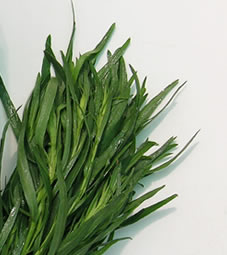Tarragon
Dill
Absinthe
Basil
Borage
Calamint
Capers
Chervil
Coriander
Tarragon
Chives
Wild fennel
Lavender
Lovage
Lippia Citriodora
Marjoram
Lemon balm
Mint
Myrtle
Oregano
Chilli pepper
Salad burnet
Parsley
Rosemary
Garden rocket
Rue
Sage
Celery
Thyme
Valerian
HISTORICAL HINTS:
Tarragon (Artemisia dracunculus) is an herbaceous aromatic plant originally from Central Asia, south Russia and Siberia; it is often called “small dragon” since its roots remind us of a dragon tangle, or “dragon herb” since this herb was believed to cure animal bites. Tarragon has thin pointed green leaves with a very strong aroma. Tarragon must be harvested before its small yellow-green cob gathered flowers bloom, so that its taste will result to be much stronger. The tarragon was spread in western Europe soon after the Crusades, while in Italy its diffusion begun from Tuscany; it was brought by Charlemagne around 774 and cultivated in St. Antimo abbey, near Montalcino. It seems that the name, Artemisia, was given in honour of Diana Artemis, who was believed to re-establish, if necessary, menstrual flux. Dracunculus, instead, means “small dragon” deriving from the fact that its bush reminds us of this animal.
CULTIVATION, VARIETIES, HARVESTING - Tarragon prefers sunny places; beside Russian tarragon, blooming from July to October, a French variety exists, but being sterile, it can only be reproduced by dividing tufts between march and April. French tarragon quality and taste are much better.
CONSUMPTION –
If bought and eaten fresh, certainly the tarragon will have a finer and stronger aroma. On the market, it is possible to find also dried tarragon; we do not recommend its use because during the drying process much of its aroma gets lost, affecting its taste.
CULINARY USE –
Tarragon can be used to aromatize eggs, fish, seafood, meats; fresh leaves can be added to salads and sauces. Tarragon taste is similar to anise and celery; slightly bitter and hot, it is good to be used with not very savoury food. Even if tarragon resists to cooking, it will maintain its original taste if added at the end; cooked tarragon will have a stronger taste so it is better to use it in small quantities. Tarragon is the main ingredient of Béarnaise sauce, tartar sauce and tarragon sauce. Tarragon has antiseptic, aromatic, stimulating and digestive properties. Greeks used to chew tarragon leaves to relieve toothache.
CURIOSITY – Fresh tarragon leaves have a sharp taste, similar to salt and pepper as a flavour-enhancer, so those who cannot eat salt for health problems, can use tarragon.























